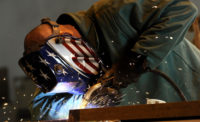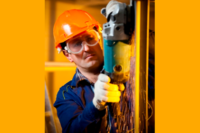1. Read the Book. A welder’s operating manual contains important safety information, as well as information procedures that maximize the machine’s potential. Make sure everyone who operates the machine is familiar with its contents.
2. Button Up. Any exposed skin is susceptible to the painful and damaging effects of ultraviolet and infrared rays. Button shirt collars, cuffs and front pockets to prevent them from catching sparks and to cover exposed skin. Do not keep matches or butane lighters in your pockets. Avoid wearing cuffed pants, as the cuffs may catch sparks.
3. Wear the Proper Gear. Neither shorts nor short-sleeved shirts belong in a welding cell. Even a quick tack weld requires the proper safety gear, including helmet, gloves and clothing.
Wear only flame-resistant clothing, such as denim pants and a shirt made from tightly woven material or a welding jacket. Gloves have progressed beyond the one-size-fits-all type. They are now available with ergonomically curved fingers and with different designs for specific welding processes. Heavy-duty MIG/Stick gloves, medium-duty MIG gloves and TIG gloves that provide added dexterity and touch and are just some of the options available. Note that gloves are not sufficient to pick up just-welded material. Use pliers to avoid burns.
4. The Right Shoes. High-top leather shoes or boots provide the best foot protection. Pants legs should go over the shoes. Do not wear tennis or cloth shoes.
5. Breathe Freely. When welding in confined spaces, toxic fumes may accumulate, or shielding gasses may replace breathable air. Use an exhaust hood to remove fumes from the area and ensure enough clean breathing air is available. Some materials specifically require respirators when welding, so consult the manufacturers welding electrode’s data sheet, your welding engineer or industrial safety specialist for proper procedures.
6. Don’t See the Light. Welding helmets should be fitted with a proper filter shade to protect the operator’s face and eyes when welding or watching. Note that approved safety glasses with side shields and ear protection should also be worn under the helmet. Install screens or barriers where appropriate to protect others from the arc.
Pick a lens shade appropriate for your welding application. OSHA offers a guide for choosing the correct lens based on welding criteria. If your weld parameters and materials don’t vary, a fixed-shade lens may be right for you.
7. Auto-Darkening Helmets. The sensors on an auto-darkening helmet darken the lens in a fraction of a second. All auto-darkening helmets must meet ANSI standards, the most recent being ANSI Z87.1-2003.
Industrial grade helmets react at speeds of 1/10,000 to 1/20,000 of a second and have adjustable shades settings of #9 to #13 for welding
8. Avoid Repetitive Stress Injuries. Compared to a traditional fixed shade helmet, an auto-darkening helmet reduces neck fatigue because it is usually lighter and operators no longer need to snap their head to drop the hood down. Also, an auto-darkening helmet saves several seconds between welds, which quickly adds up to several minutes on larger components. Saving these minutes enables a company to more easily adhere to its build time.
9. Lose the Clutter. There is a place for everything, and everything in its place. The weld area contains only the tools and equipment that operator uses; nothing more, nothing less
10. Use Boom-Mounted Wire Feeders. Boom-mounted wire feeders add flexibility, efficiency and operator comfort to high-production welding stations. Booms place the wire feeder controls at the base of a 12- or 16-ft. boom and the drive assembly at the end of the boom.
11. Optimize Fixturing. Use fixturing whenever possible. The simple rotates a 2,200-lb. component. It increases safety by eliminating the use of a chain and hoist to flip the component, which in turns eliminates the source of potential hazards.
12. Stick and Carrot Approaches. For successful implementation, don’t make welding safety a “program.” Employees tend to suspect programs, as programs tend to fade away after a brief flurry of initial activity. Instead, incorporate safety into daily work habits and incentivize compliance.
The stick approach: employees who witness a safety violation and do not report it could be subject to the same consequences as the violator. This conveys a corporation’s safety conviction .Overall, most companies choose to blend stick and carrot approaches as part of their efforts.
When welding safety becomes an ingrained part of your corporate culture, you can expect reduced lost-time incidences and improved productivity.
Source: Miller Welds www.millerwelds.com



